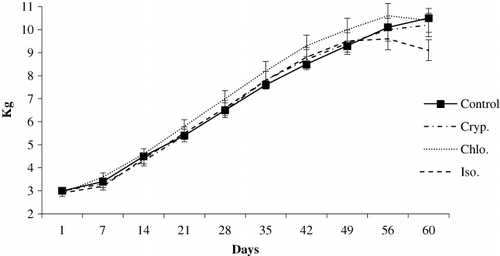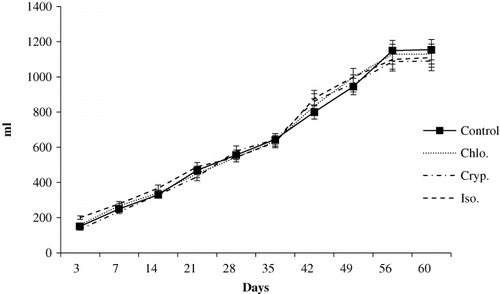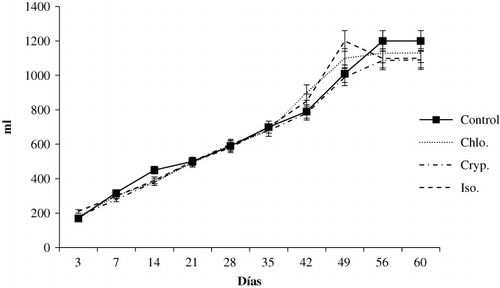Abstract
The effects of Crypthecodinium cohnii (Cryp.), Chlorela spp. (Chlo.) and Isochrysis galbana (Iso.) addition to milk replacer on goat kids and lambs growth were evaluated. About 80 Majorera goat kids (males and females) and 80 Canarian sheep lambs were randomly assigned into four different groups (by specie) according to diet. Control groups were fed with a commercial milk replacer at 16% (w/w); Cryp. groups received a commercial milk replacer (15.1% w/w) supplemented with 9 g of a paste of C. cohnii; Chlo. groups received a commercial milk replacer (15.1% w/w) supplemented with 9 g of a paste of Chlorela spp.; Iso. groups received a commercial milk replacer (15.1% w/w) supplemented with 9 g of a paste of I. galbana. After colostrum period, animals were individually bottle-fed twice daily (8 am and 8 pm) ad libitum with the corresponding diet until day 60 of life. Animals were weighted every week at 8 am and liquid diet intake was recorded weekly. No effects of microseaweed addition were observed, neither growth nor milk replacer intake.
Introduction
Small ruminant research is growing nowadays (Arguello Citation2011). Furthermore, the number of small ruminants dairy farms is increasing and in order to have the whole produced milk available for manufacturing (Napolitano et al. Citation2008), artificial rearing system may be the best option to feed goat kids and lambs.
Goat kids and lambs growth have been studied deeply in the past (Arguello et al. Citation2004a), but the microseaweed inclusion in the diet is a new topic, however no information is available.
Although, the majority of literature found about the inclusion of marine algae in growing ruminants diet have investigated its effect on muscle fatty acid composition (Shingfield et al. Citation2013). An interesting review (Christaki et al. Citation2010) addressed the use of algae as feed in animal nutrition. Authors resume that algae rations addition in lactating cows has increased milk production and milk protein. In calves (22 months old), the dietary algae enhanced immune function and improved carcass characteristics. In sheep, the algae nutrition affected milk fat composition. But they conclude that further investigation is needed about the use of algae in animal nutrition.
The effects of marine algae on cow milk production have been recently addressed. Wullepit et al. (Citation2012) induced milk fat depression in early lactation by feeding docosahexaenoic acid (DHA) from seaweed, however the use of DHA could not improve the energy balance. The DHA addition increased lipid peroxidation.
Travnicek et al. (Citation2008) observed the effect of supplementation of selenium inorganic and organic forms (using Chlorella spp.) on the activity of glutathione peroxidase in newborn lambs. The positive effect of selenium supplementation in ewes contributed to higher activity of glutathione peroxidase in the whole blood of the lambs and higher selenium concentration on blood serum.
Recently, Moreno-Indias et al. (Citation2012) studied the effect of docosahexaenoic acid (DHA-Gold®) addition to milk replacer on goat kids meat quality and immunity. Results indicated that the diet containing DHA did not affect the IgG, IgM concentration or complement system activity during the first month of life, but the influence on cellular immunology was not tested.
Due to the limited knowledge about the use of seaweed in the small ruminant (goat kids and lambs) newborn growth, the aim of the present study is to investigate the effects of the different sources of microseaweed in the small ruminant newborn growth.
Material and methods
The present experiment was conducted at the Veterinarian Faculty of Universidad de Las Palmas de Gran Canaria (Spain). About 80 Majorera goat kids (males and females) and 80 Canarian sheep lambs were randomly assigned into four different groups (by specie) according to diet. At birth, the newborns were separated from their mothers and dried. Their umbilical cords were disinfected. Then, they were weighed and assigned to one of the four experimental groups by specie. Goat kids and lambs were bottle-fed colostrum from a pool prepared prepartum, according to the kid management protocol described by Arguello et al. (Citation2004b) with modifications suggested by Trujillo et al. (Citation2007). Then, beginning with the fourth feed, kids and lambs received their corresponding diets as follows: Control groups were fed with a commercial milk replacer (Bacilactol Cabritos, Saprogal, La Coruna, Spain; 95.5% dry matter (DM), 23.6% crude protein (CP), and 22.7% ether extract) at 16% (w/w); Cryp. groups received a commercial milk replacer (15.1% w/w) supplemented with 9 g of a paste of Crypthecodinium cohnii; Chlo. groups received a commercial milk replacer (15.1% w/w) supplemented with 9 g of a paste of Chlorela spp.; Iso. Groups received a commercial milk replacer (15.1% w/w) supplemented with 9 g of a paste of Isochrysis galbana. Animals were individually bottle-fed twice daily (8 am and 8 pm) ad libitum according to (Arguello et al. Citation2004a), with the corresponding diet until day 60 of life. Animals were weighted every week at 8 am and results were expressed in kg (MOBBA, Barcelona, Spain; accuracy, 5g). Furthermore, liquid diet intake was recorded weekly.
The SAS (Version 9.00, SAS Institute Inc., Cary, NC) program package was used for statistical analysis. A PROC MIXED procedure factorial ANOVA (analysis of variance with repeated measures) was performed to evaluate the effects of the diets on growth and milk replacer intake.
Results and discussion
shows the goat kids growth curves in control and experimental groups from birth to day 60 of life. Birth weight, intermediate weights and weight at day 60 are similar to those observed previously by Marichal et al. (Citation2003) in the same breed. No effects of microseaweeds addition in the milk replacer were observed on growth. The effect of adding fat to diets for ruminants depends not only on the type of fat but also on the amount added (Manso et al. Citation2009). Nevertheless, in the present experiment, animal performance was not affected, since no differences were observed in the growth rate or in the food efficiency ratio, although in pigs and other species, fish oil supplementation has been found to reduce the inflammatory response and this fact may benefit the growth performance (Gabler and Spurlock Citation2008). In reference to milk replacer intake (), no effects of microseaweeds addition in the milk replacer were observed. Similar milk replacer intakes were reported by Arguello (Citation2000) in the same breed at similar ages. Voluntary-feed intake of milk replacer by pre-ruminant animals is influenced by the DM content in the milk replacer (Sanz Sampelayo et al. Citation2003), and for this reason it was decided to keep the amount of DM constant during the experimental time. On the other hand, Wistuba et al. (Citation2005) observed a decrease in the average daily gain (ADG) and in voluntary feed intake in cattle when 3% fish oil was added to the diet. Differences on fat percentage would be the reason of that discrepancy.
and show the growth curves and milk replacer intake for the four lambs experimental groups. No significant effects of different seaweed addition on milk replacer were observed, neither growth nor milk replacer intake. Similar ADGs were observed by Ripoll-Bosch et al. (Citation2012) in other Spanish breed sheep (Ojinegra). Currently, the reported results are the first ones about Canarian sheep. The no differences between experimental groups might be raised in that all experimental animals received the same total DM, although control group lambs received all the DM from the milk replacer. Similarly, no effect on lamb growth has been observed by Lewis et al. (Citation2008) using milk replacer supplemented with fish oil or safflower. Although, it has been mentioned by Carroll et al. (Citation2003), Gaines et al. (Citation2003) and Liu et al. (Citation2003) that growth (in pigs) is improved when animals are fed with fish oil and they are under immune challenge; results from Lewis et al. (Citation2008) and present work indicate that under no infection or immune challenge the omega 3 sources addition to milk replacer did not improve the growth performances in lambs.
Conclusion
The addition of C. cohnii, Chlorela spp. and I. galbana to milk replacer did not improve the goat kids and lambs growth or relative performances.
Acknowledgement
The present study was supported by the Spanish Government Grant AGL2009-11944.
References
- Arguello A. 2000. Lactancia artificial de cabritos: importancia del encalostrado, crecimiento y calidad de la canal y de la carne [Goat kids artificial rearing: colostrum feed importance, growth and carcass and meat quality] [Ph.D.]. Las Palmas de Gran Canaria: Universidad de Las Palmas de Gran Canaria.
- Arguello A. 2011. Trends in goat research, a review. J Appl Anim Res. 39:429–434.10.1080/09712119.2011.637362
- Arguello A, Castro N, Capote J. 2004a. Growth of milk replacer kids fed under three different managements. J Appl Anim Res. 25:37–40.10.1080/09712119.2004.9706470
- Arguello A, Castro N, Capote J, Tyler JW, Holloway NM. 2004b. Effect of colostrum administration practices on serum IgG in goat kids. Livest Prod Sci. 90:235–239.10.1016/j.livprodsci.2004.06.006
- Carroll JA, Gaines AM, Spencer JD, Allee GL, Kattesh HG, Roberts MP, Zannelli ME. 2003. Effect of menhaden fish oil supplementation and lipopolysaccharide exposure on nursery pigs – I. Effects on the immune axis when fed diets containing spray-dried plasma. Domest Anim Endocrinol. 24:341–351.10.1016/S0739-7240(03)00017-1
- Christaki E, Karatzia M, Florou-Paneri P. 2010. The use of algae in animal nutrition. J Hellenic Vet Med Soc. 61:267–276.
- Gabler NK, Spurlock ME. 2008. Integrating the immune system with the regulation of growth and efficiency. J Anim Sci. 86:E64–E74.10.2527/jas.2007-0466
- Gaines AM, Carroll JA, Yi GF, Allee GL, Zannelli ME. 2003. Effect of menhaden fish oil supplementation and lipopolysaccharide exposure on nursery pigs II. Effects on the immune axis when fed simple or complex diets containing no spray-dried plasma. Domest Anim Endocrinol. 24:353–365.10.1016/S0739-7240(03)00016-X
- Lewis GS, Wulster-Radcliffe MC, Herbein JH. 2008. Fatty acid profiles, growth, and immune responses of neonatal lambs fed milk replacer and supplemented with fish oil or safflower oil. Small Ruminant Res. 79:167–173.10.1016/j.smallrumres.2008.07.024
- Liu YL, Li DF, Gong LM, Yi GF, Gaines AM, Carroll JA. 2003. Effects of fish oil supplementation on the performance and the immunological, adrenal, and somatotropic responses of weaned pigs after an Escherichia coli lipopolysaccharide challenge. J Anim Sci. 81:2758–2765.
- Manso T, Bodas R, Castro T, Jimeno V, Mantecon AR. 2009. Animal performance and fatty acid composition of lambs fed with different vegetable oils. Meat Sci. 83:511–516.10.1016/j.meatsci.2009.06.035
- Marichal A, Castro N, Capote J, Zamorano MJ, Argüello A. 2003. Effects of live weight at slaughter (6, 10 and 25 kg) on kid carcass and meat quality. Livest Prod Sci. 83:247–256.
- Moreno-Indias I, Morales-delaNuez A, Hernandez-Castellano L, Sanchez-Macias D, Capote J, Castro N, Arguello A. 2012. Docosahexaenoic acid in the goat kid diet: effects on immune system and meat quality. J Anim Sci. 90:3729–3738.10.2527/jas.2011-4351
- Napolitano F, Pacelli C, Girolami A, Braghieri A. 2008. Effect of information about animal welfare on consumer willingness to pay for yogurt. J Dairy Sci. 91:910–917.10.3168/jds.2007-0709
- Ripoll-Bosch R, Alvarez-Rodriguez J, Blasco I, Picazo R, Joy M. 2012. Milk production and lamb growth in Ojinegra sheep breed. Itea – Inf Tecnica EconAgraria. 108:298–311.
- Sanz Sampelayo MR, Allegretti L, Gil Extremera F, Boza J 2003. Growth, body composition and energy utilisation in pre-ruminant goat kids: effect of dry matter concentration in the milk replacer and animal age. Small Ruminant Res. 49:61–67.
- Shingfield KJ, Bonnet M, Scollan ND. 2013. Recent developments in altering the fatty acid composition of ruminant-derived foods. Animal. 7 Suppl 1:132–162.
- Travnicek J, Racek J, Trefil L, Rodinova H, Kroupova V, Illek J, Doucha J, Pisek L. 2008. Activity of glutathione peroxidase (GSH-Px) in the blood of ewes and their lambs receiving the selenium-enriched unicellular alga Chlorella. Czech J Anim Sci. 53:292–298.
- Trujillo AJ, Castro N, Quevedo JM, Arguello A, Capote J, Guamis B. 2007. Effect of heat and high-pressure treatments on microbiological quality and immunoglobulin G stability of caprine colostrum. J Dairy Sci. 90:833–839.
- Wistuba TJ, Kegley EB, Apple JK, Davis ME. 2005. Influence of fish oil supplementation on growth and immune system characteristics of cattle. J Anim Sci. 83:1097–1101.
- Wullepit N, Hostens M, Ginneberge C, Fievez V, Opsomer G, Fremaut D, De Smet S. 2012. Influence of a marine algae supplementation on the oxidative status of plasma in dairy cows during the periparturient period. Prev Vet Med. 103:298–303.




